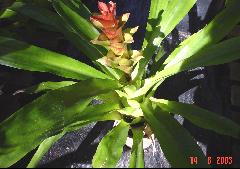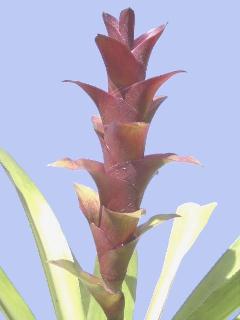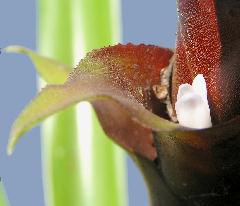


“The sub cylindrical inflorescence is the most striking feature of this species and makes it easy to distinguish from the other taxa of the genus. Morphologically, it is most closely related to C. billbergioides. Besides the unique inflorescence shape, other traits that distinguish C. seidelii include its stoutness, leaves with a broadly acute apex, very wide primary bracts which are better able to retain water, larger flowers and much wider sepals.
As in C. billbergioides, there is a slight color variation in the primary bracts of C. seidelii, which may be greenish, reddish or yellow; the latter color predominates (see also the specimen depicted by Mee: 101.1992). A herbarium specimen with dark red primary bracts is deposited in the Barbosa Rodrigues Herbarium. This specimen was collected by Seidel (571) and contains the inscription "var. welteri Reitz.", but the varietal name is not valid because it was never published. Even if it had been published, it would be listed as a synonym because this color falls within the normal variation of the species.”
We know that Lyman Smith treated Nidularium billbergioides as being very variable in the colour of the primary bracts as well as the leaves. These have been covered at Cultivar level by calling each identifiable form after the name of a fruit. We still come across additions to this list. To check this refer to the online Cultivar Register by entering ‘Billbergioides’ in the top box.
In this case, Elton believed the same situation applied with Canistropsis seidelii and all has been quiet. I did enter the name var. welteri as a nomen nudum in the species database on fcbs.org more as a reference in case others had this name on their label and didn’t know much about it. Because of this I was able to point Jan Townsend of the Hunter District group in this direction.
There has now been an interesting development although whether it will be accepted by fellow taxonomists in a sort of peer review has yet to be decided. In the first edition of Die Bromelie (the German Society Journal) for 2006 I found amongst all the Tillandsia talk an article by Juergen Roeth on Canistropsis seidelii var welteri. I am used to translating articles from the German for Tillandsias but here we had a chap who wrote in different German!! But I managed to get it translated! He did give a Latin diagnosis but it translated differently to his German diagnosis!! Confused? Well, I was but it still seems legitimate because the Latin diagnosis overrides the German one.
I call myself a quasi-taxonomist (pronounce it as you may) but here I saw what I call sloppy taxonomy work. He referred to Leme’s book but not a word about the herbarium specimen of Seidel no. 571 nor did he give any reasoning why he considered Leme to be in error.
So there it is. I thought you should know because some are growing var. welteri as I am, but its status at varietal level is on shaky ground! We may even have to deal with it as a cultivar – now that is a ‘Welter’ of an idea!


